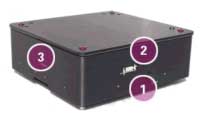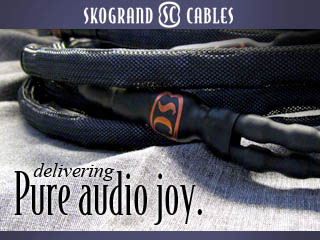1 – Vertical Load Adjustment Crank
Simple manual adjustment compensates for changes in vertical load.
2 – Vertical Load Adjustment Indicator
Easily determine optimum setting using this simple visual indicator.
3 – Vertical Stiffness Adjustment Screw
Dial in Guaranteed 1/2 Hz or less Vertical natural frequency using this simple adjustment.

The curve below shows the typical vertical 1/2 Hz performance of the BM-1. It offers 10-100 times better performance than typical high-performance air tables.—Minus K
It’s Touchy
Like setting the bias in a tube amp with a bunch of parallel pentodes, it takes a while to get the Minus K tweaked to perfection. I had intended to use one of my turntables. Both tables are heavy, weighing from 55 to 70 pounds, but that wasn’t quite enough for the platform I asked for, namely the 100BM-1. I tried using the ballast I had at hand, but the two turntables were hard to balance. Rather than spend dollars buying ballast, and many days precisely balancing the setup, just to tear it down, it was decided that a tube amp would make a good test subject. All vacuum tube pieces are prone to ringing and microphonics, and the Raven Audio Reflection integrated amp that was here for review had a phalanx of tubes, fourteen total, I believe.
The Raven wasn’t overly sensitive to ringing, but it could be easily excited by thumping and tapping. Even here, I ran into the problem of cords. This is such a finely balanced device that a stiff cable will “wag the dog.” My overly stiff speaker cables, and ridiculously stiff power cable required lots of changes in positioning—I would move the amp, move the cables and move the isolation base. Then I would do it again. Then I would do it a few more times. After much moving and adjusting, the Minus K was centered front to back, side to side and top to bottom. In a way, it reminded me of setting up classic spring suspension turntables, like the LP12, AR XA, etc.. The reason people have migrated away from those classic designs has more to do with the difficulty of setting them up properly than performance issue.
For instance, when you changed the tonearm on a spring suspended turntable, it would change the center of gravity, the flatness of the setup, and the resonance frequency of that corner of the turntable. In an ideal world, those spring-suspended turntables would be designed to work with a particular mass of tonearm, and provisions would be to add/remove lead shot from the armboard to keep the turntable level, and with a unified resonance frequency. So, the Minus K reminds me of those finicky designs, though it is even more sensitive to small adjustments because the range of motion is not as “progressive” as with springs, which gets progressively more difficult to deflect as you pushed/pulled from the resting place of the spring. This one feels more like you are in a liquid or magnetic field, and you can move freely until you hit the travel limits.
It’s much easier to make an overkill solid plinth. It also reminds me of what F1 teams goes through to tune a new car. They spend many hours running a course, checking telemetry, making adjustments, and then they do it again, sometimes for weeks. If you really care about your audio, you’ll spend weeks getting it right.
The Minus K doesn’t have a sound. When properly adjusted, the Minus K removes the smear that decreases image depth and width, obliterates low-level signals, robs dynamic power and creates listener fatigue. With most systems, listening at high levels is the same as out-of-control listening. With the Minus K, there is greater musical intensity, without the frenetic qualities of an out-of-control system. Very demanding orchestral recordings, like the Bernstein-Chicago live recording of Shostakovich’s “Leningrad Symphony,” don’t scream as much as they usually do. That particular recording is far from great, but can sound horrible on some equipment. The low brass tone and bite were much clearer. Double bass and cello lines were both easier to follow, while having a truer harmonic signature. Without the Minus K, you can hear the microphonic tubes modulate the signal from acoustic feedback, creating a peculiar flavor of intermodulation distortion. That’s the best way I can describe what the Minus K achieves: lower IM distortion. It mostly isolates the electronics from the acoustics, lowering distortion that behaves very much like intermodulation distortion.
Due to the materials, mass, and the large dimensions of the 100BM-1, the “skirt/apron” could be made to ring. The skirt is isolated from the load, but there is the possibility that it could ring, creating a source of noise. With the smaller units offered by Minus K, I don’t foresee as much of an issue. There are several steps that could be taken to eliminate the ringing, and all could be hidden from the listener.
Another issue for some potential buyers will be the pedestrian looks. It’s not ugly, but it’s not attractive. It reminds me of the VPI 16.5 record cleaner. It just is. It exists to perform its duties. It’s not a problem for me, but it will be for some who value aesthetics as much as sound.
Bass impact and depth were other areas markedly improved. After being freed from the acoustical echo, which is significantly slower in arriving than the speedy electrical signal, the leading edge of midrange and bass transients were cleaner. I heard no tube ringing the way I often do when hitting “pause” or “mute” in the middle of a loud passage. It’s an easy test: Play very noisy music, crank it up, and then hit pause. Do you hear any ringing, like a wine glass? If so, then you have a problem. I have always used tube damping rings, but they have only been partially successful. With the Minus K I still heard a benefit with damping rings, and more than usual. The damping rings push the resonance frequency lower, which allows the Minus K to be more effective.
For What Purpose?
I originally intended an analog application, but wound up testing tubes. Both operations need help. I can see a system that employs several Minus Ks for turntables, tape decks, other source components, preamps and amps, interconnected with carefully chosen cables. In my experience, everything is affected by vibration. The only application that doesn’t make sense is for the speakers themselves. Speakers need to be affixed firmly to the floor for best resolution. Without isolation devices, the only way to take vibration out of the equation is moving sources and electronics to the other side of a massively built wall. I’ve heard one system with a similar approach, and it makes an amazing difference. On the other hand, the majority will either want to see their expensive components, won’t have enough space to sacrifice, or won’t have the money for such a radical step. I don’t know if five or six of the Minus K platforms will be cheaper than redesigning, and rebuilding your listening room, but they are the next best solution.
In the Minus K isolation platforms, I believe audiophiles have a thoroughly designed instrument with a reasonable price. While others will be easier to set up and use, the Minus K will do a better job. If it weren’t for the monumental hassle of constantly changing components, and the demands of reviewing, the Minus K would’ve been a no-brainer purchase. If you are happy with your components, and want to take your system to the next level of performance, you should give these isolation platforms an audition. You’ll be surprised by what you don’t hear.
- ← Previous page
- (Page 2 of 2)



I agree with this reviewer in regards to having sensitive equipment in another room, or isolation chamber. Many Audiophiles use devises to absorb vibrations. The problem with this is the vibrations have to be in the audio component first, in order to be absorbed. Therefore, the platforms and anti-resonant devises only reduce, and or ‘tune’ the resonances and vibration.
Bill,
Thanks for the comments. The three biggest problems in audio are: the room, microphonics/feedback and equipment interface (impedance mismatch, RCA jacks, etc..). All three are challenging to address. It’s no wonder that very few companies even try.
Regards,
Phillip
I am looking for spec’s on a Model 100bm-8, which we have